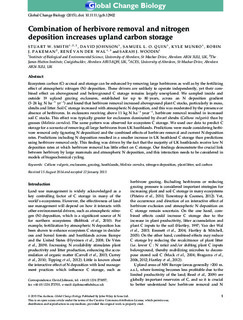| dc.contributor.author | Smith, Stuart | |
| dc.contributor.author | Johnson, David | |
| dc.contributor.author | Quin LO, Samuel | |
| dc.contributor.author | Munro, Kyle | |
| dc.contributor.author | Pakeman, Robin J | |
| dc.contributor.author | van der Wal, René | |
| dc.contributor.author | Woodin, Sarah J. | |
| dc.date.accessioned | 2019-03-21T09:14:06Z | |
| dc.date.available | 2019-03-21T09:14:06Z | |
| dc.date.created | 2016-08-20T11:41:38Z | |
| dc.date.issued | 2015 | |
| dc.identifier.citation | Global Change Biology. 2015, 21 3036-3048. | nb_NO |
| dc.identifier.issn | 1354-1013 | |
| dc.identifier.uri | http://hdl.handle.net/11250/2590996 | |
| dc.description.abstract | Ecosystem carbon (C) accrual and storage can be enhanced by removing large herbivores as well as by the fertilizing effect of atmospheric nitrogen (N) deposition. These drivers are unlikely to operate independently, yet their combined effect on aboveground and belowground C storage remains largely unexplored. We sampled inside and outside 19 upland grazing exclosures, established for up to 80 years, across an N deposition gradient (5–24 kg N ha−1 yr−1) and found that herbivore removal increased aboveground plant C stocks, particularly in moss, shrubs and litter. Soil C storage increased with atmospheric N deposition, and this was moderated by the presence or absence of herbivores. In exclosures receiving above 11 kg N ha−1 year−1, herbivore removal resulted in increased soil C stocks. This effect was typically greater for exclosures dominated by dwarf shrubs (Calluna vulgaris) than by grasses (Molinia caerulea). The same pattern was observed for ecosystem C storage. We used our data to predict C storage for a scenario of removing all large herbivores from UK heathlands. Predictions were made considering herbivore removal only (ignoring N deposition) and the combined effects of herbivore removal and current N deposition rates. Predictions including N deposition resulted in a smaller increase in UK heathland C storage than predictions using herbivore removal only. This finding was driven by the fact that the majority of UK heathlands receive low N deposition rates at which herbivore removal has little effect on C storage. Our findings demonstrate the crucial link between herbivory by large mammals and atmospheric N deposition, and this interaction needs to be considered in models of biogeochemical cycling. | nb_NO |
| dc.language.iso | eng | nb_NO |
| dc.publisher | Wiley | nb_NO |
| dc.rights | Navngivelse 4.0 Internasjonal | * |
| dc.rights.uri | http://creativecommons.org/licenses/by/4.0/deed.no | * |
| dc.title | Combination of herbivore removal and nitrogen deposition increases upland carbon storage | nb_NO |
| dc.type | Journal article | nb_NO |
| dc.type | Peer reviewed | nb_NO |
| dc.description.version | publishedVersion | nb_NO |
| dc.source.pagenumber | 3036-3048 | nb_NO |
| dc.source.volume | 21 | nb_NO |
| dc.source.journal | Global Change Biology | nb_NO |
| dc.identifier.doi | 10.1111/gcb.12902 | |
| dc.identifier.cristin | 1374250 | |
| dc.description.localcode | © 2015 The Authors. Global Change Biology Published by John Wiley & Sons Ltd. This is an open access article under the terms of the Creative Commons Attribution License, which permits use, distribution and reproduction in any medium, provided the original work is properly cited. | nb_NO |
| cristin.unitcode | 194,66,10,0 | |
| cristin.unitname | Institutt for biologi | |
| cristin.ispublished | true | |
| cristin.fulltext | original | |
| cristin.qualitycode | 2 | |

